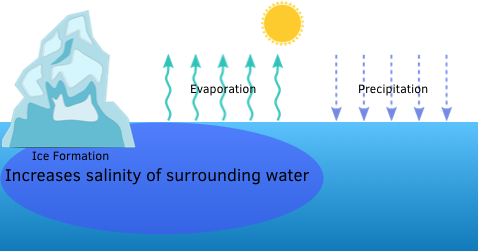Thermohaline Circulation
Circulation in the oceans helps transport the solar energy that falls at the equator towards the poles. Like the atmosphere, uneven heating drives this flow of energy poleward. Unlike the atmosphere, the oceans are warmed from the top-down rather than from the bottom up, so heat-driven convection is not enough to cause ocean circulation. For density-driven circulation to mix the oceans at a large enough scale to matter, changes in both temperature and salinity are required.
Test your understanding of thermohaline circulation with a quiz
Ocean salinity is relatively constant over large regions of the ocean. However, small variations do occur due to latitudinal patterns in evaporation and precipitation. The zone of rainfall associated with the low-pressure system around the equator causes lower salinities near the equator. Salinity then increases through the mid-latitudes due to evaporation in the regions where the lower portion of the Hadley cell moves dry air towards the equator. Salinity then decreases again towards the poles where there is an increase in precipitation associated with the low-pressure region between the Ferrel and Polar cells.

In addition to evaporation and precipitation, the formation of ice changes the salinity of seawater. As saltwater freezes to form ice, the ice crystals exclude the salt increasing the salinity of the water left behind. In regions near the poles, where significant ice formation occurs, the excluded salt ends up in the surrounding water, leaves that water cold enough, and salty enough to sink. This triggers a slow but significant large-scale circulation cycle.

The sinking of dense water triggered by ice formation only occurs in a few places on Earth: Two locations in the North Atlantic and one region near Antarctica in the Southern Ocean.

The bottom water formed near Antarctica (called Antarctic Bottom Water) spreads around the Southern Ocean and moves up into all the other large ocean basins. This Antarctic bottom water is the densest in the oceans. As a result, it fills the bottom of much of the Earth's oceans. The deepwater formed in the North Atlantic (called North Atlantic Bottom Water) spreads southward along the bottom North Atlantic. It flows through the South Atlantic into the southern ocean and, along with Antarctic bottom water, fills the depths of all the Earth's oceans.
The process by which the deepwater slowly mixes with other water masses and eventually makes it to the surface is not well understood, but eventually, in regions of upwelling and through slow mixing of different water masses, the deepwater formed near the poles reaches the surface. Once at the surface, this water warms and slowly completes the cycle returning from the Indian and Pacific Oceans through the Southern Ocean into the Atlantic and back to the places where deep water is forms.

This is a very slow process. It takes upwards of 1,000 years to complete the cycle. The formation of dense, deep water formation at high latitudes which drives a slow, steady movement of warm surface water towards the poles, is called thermohaline circulation. It is also referred to as the ocean conveyor belt, and it is responsible for moving significant amounts of heat from the equator towards the poles
